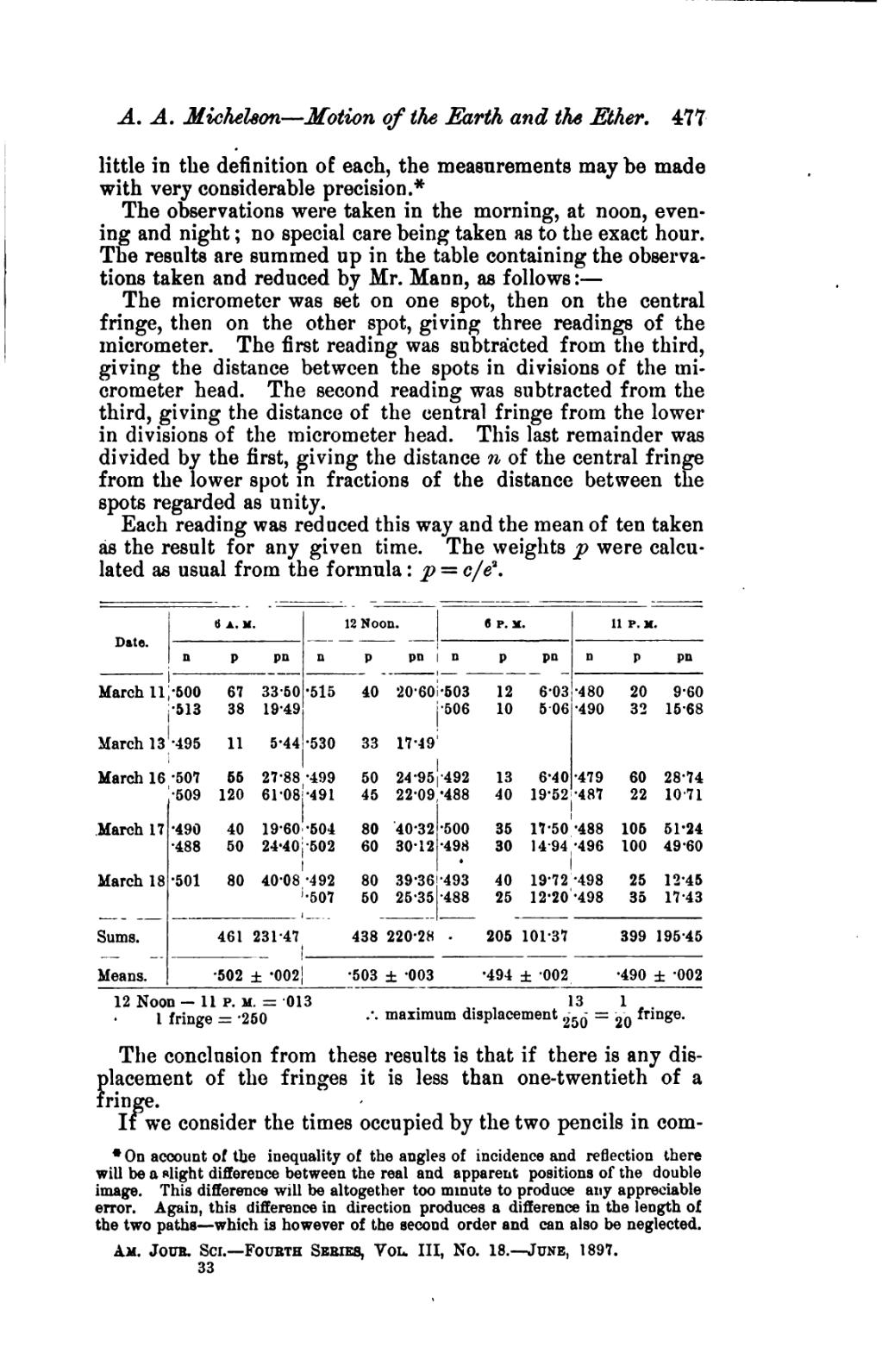little in the definition of each, the measurements may be made with very considerable precision.[1]
The observations were taken in the morning, at noon, evening and night; no special care being taken as to the exact hour. The results are summed up in the table containing the observations taken and reduced by Mr. Mann, as follows:—
The micrometer was set on one spot, then on the central fringe, then on the other spot, giving three readings of the micrometer. The first reading was subtracted from the third, giving the distance between the spots in divisions of the micrometer head. The second reading was subtracted from the third, giving the distance of the central fringe from the lower in divisions of the micrometer head. This last remainder was divided by the first, giving the distance n of the central fringe from the lower spot in fractions of the distance between the spots regarded as unity.
Each reading was reduced this way and the mean of ten taken as the result for any given time. The weights p were calculated as usual from the formula: .
Date. |
6 A.M. |
12 Noon. |
6 P.M. |
11 P.M. | ||||||||
n |
p |
pn |
n |
p |
pn |
n |
p |
pn |
n |
p |
pn | |
|
March 11 |
.500
|
67
|
33.50
|
.515
|
40
|
20.60
|
.503
|
12
|
6.03
|
.480
|
20
|
9.60
|
.513
|
38
|
19.49
|
.506
|
10
|
5.06
|
.490
|
32
|
15.68
| ||||
|
March 13 |
.495
|
11
|
5.44
|
.530
|
33
|
17.49
|
||||||
|
March 16 |
.507
|
55
|
27.88
|
.490
|
50
|
24.95
|
.492
|
13
|
6.40
|
.479
|
60
|
28.74
|
.509
|
120
|
61.08
|
.491
|
45
|
22.09
|
.488
|
40
|
49.52
|
.487
|
22
|
10.71
| |
|
March 17 |
.490
|
40
|
19.60
|
.504
|
80
|
40.32
|
.500
|
35
|
17.50
|
.488
|
105
|
51.24
|
.488
|
50
|
24.40
|
.502
|
60
|
30.12
|
.498
|
30
|
14.94
|
.496
|
100
|
49.60
| |
|
March 18 |
.501
|
80
|
40.08
|
.492
|
80
|
39.36
|
.493
|
40
|
19.72
|
.498
|
25
|
12.45
|
.507
|
50
|
25.35
|
.488
|
25
|
12.20
|
.498
|
35
|
17.43
| ||||
|
Sums. |
461
|
231.47
|
438
|
220.28
|
205
|
101.37
|
399
|
195.45
| ||||
|
Means |
.502 ± .002 |
.503 ± .003 |
.494 ± .002 |
.490 ± .002 | ||||||||
12 Noon - 11 P. M. = .013
1 fringe = .250 maximum displacement fringe.
The conclusion from these results is that if there is any displacement of the fringes it is less than one-twentieth of a fringe.
If we consider the times occupied by the two pencils in completing
- ↑ On account of the inequality of the angles of incidence and reflection there will be a slight difference between the real and apparent positions of the double image. This difference will be altogether too minute to produce any appreciable error. Again, this difference in direction produces a difference in the length of the two paths—which is however of the second order and can also be neglected.



